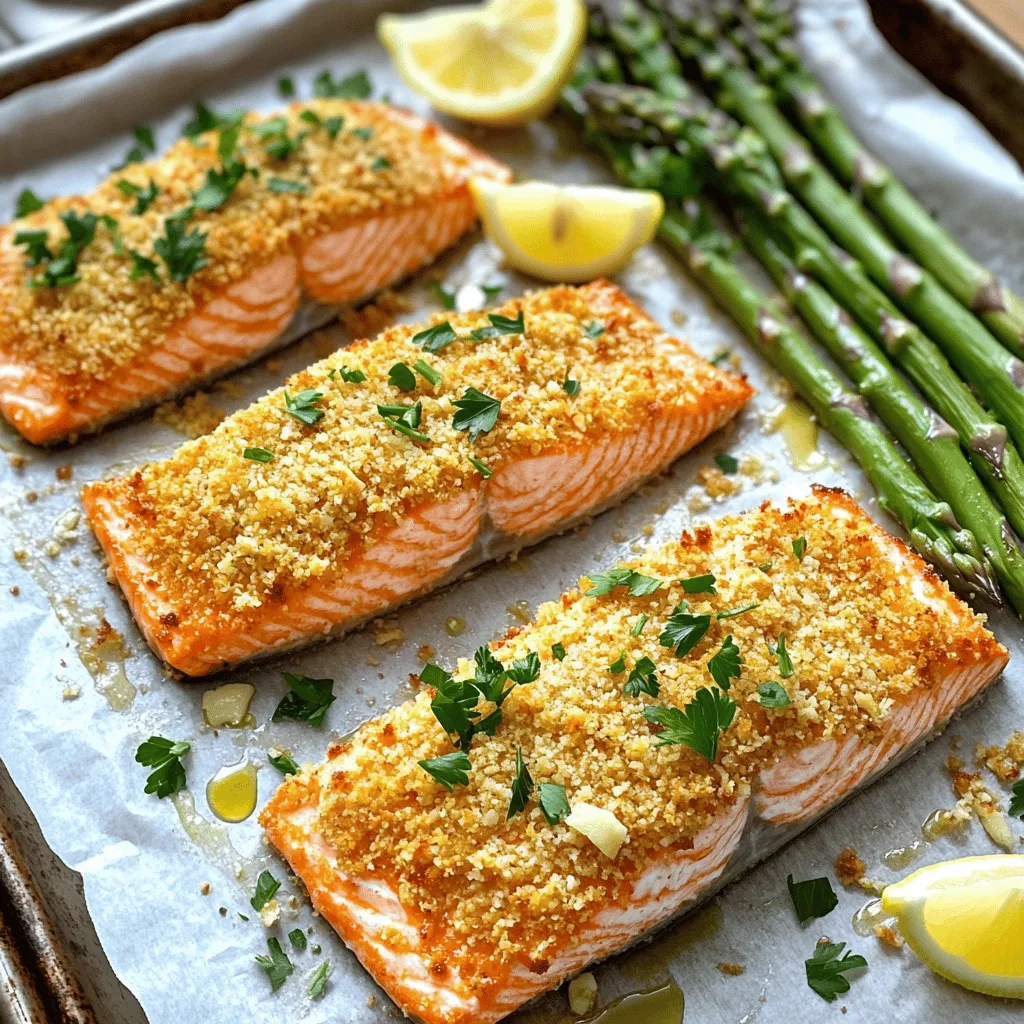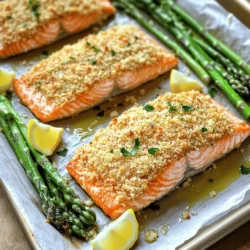If you’re looking for a quick and tasty meal, this Garlic Parmesan Crusted Salmon Sheet Pan Delight is for you! It’s simple to prepare, and we’ll cover all the tasty ingredients you need. With easy steps for cooking and tips to get that perfect crust, you’ll feel like a chef in your kitchen. Let’s dive into this dish that brings flavor and fun to your dinner table!
Ingredients
List of Main Ingredients
For this Garlic Parmesan Crusted Salmon, gather these main items:
– 4 salmon fillets
– 1 cup breadcrumbs (Panko preferred for crunch)
– 1/2 cup grated Parmesan cheese
– 4 cloves garlic, minced
– 2 tablespoons fresh parsley, chopped
– 1 teaspoon lemon zest
– 1 tablespoon olive oil
– Salt and pepper to taste
Optional Vegetables for Sides
You can add veggies for more flavor and nutrition. Here are great options:
– 1 pound asparagus, trimmed
– Broccoli florets
– Bell peppers, sliced
– Zucchini, cut into rounds
Seasoning Breakdown
The seasoning mix brings this dish alive. Here’s what each part does:
– Garlic: Adds a robust flavor that pairs well with fish.
– Parmesan cheese: Gives a salty, nutty taste and great crust.
– Lemon zest: Brightens the dish with a fresh, tangy note.
– Fresh parsley: Introduces a hint of green and a mild flavor.
– Olive oil: Helps the crust stick and keeps the fish moist.
– Salt and pepper: Enhances all the flavors and balances the dish.
Feel free to customize the sides and seasonings to fit your taste!
Step-by-Step Instructions
Preparation Steps
Start by preheating your oven to 400°F (200°C). This heat will help make the salmon crispy. Next, line a large baking sheet with parchment paper. This step makes cleanup fast and easy. In a medium bowl, mix the breadcrumbs, grated Parmesan cheese, minced garlic, chopped parsley, lemon zest, and olive oil. Stir until the mix is crumbly and well combined. This mix adds great flavor to your salmon.
Now, season your salmon fillets with salt and pepper on both sides. This simple step boosts the taste. Place the salmon skin-side down on the prepared baking sheet. Spoon the breadcrumb mixture generously over each fillet. Press down gently so it sticks well. This crust will turn golden and crunchy when baked.
Cooking Process
Next, arrange the asparagus around the salmon. You can choose other veggies if you wish. Drizzle olive oil over the veggies and season them with salt and pepper. This adds flavor to the sides. Now, place the baking sheet in the oven. Bake for 12-15 minutes. The salmon is done when its internal temperature reaches 145°F. You want the crust to be golden brown and the salmon flaky.
Once cooked, take the baking sheet out of the oven. Let it rest for a few minutes before serving. This resting time helps keep the salmon moist and tasty.
Tips for Perfect Baking
For a perfect bake, use fresh ingredients. Fresh garlic and parsley will enhance the flavor. Keep an eye on the salmon while it cooks. Ovens can vary, so check it a bit early. If you want a crispier crust, broil the salmon for the last 2 minutes. This adds a nice crunch.
When serving, plate the salmon and asparagus neatly. Garnish with lemon wedges and a sprinkle of fresh parsley. This not only looks good but adds a pop of color. Enjoy every bite of your Garlic Parmesan Crusted Salmon!
Tips & Tricks
How to Achieve the Best Crust
To get the best crust on your salmon, use Panko breadcrumbs. They add a nice crunch. Mix them with grated Parmesan, minced garlic, and lemon zest. This mix gives great flavor. Press the mixture onto the salmon firmly. This helps it stick during baking. Bake until the crust is golden brown. This should take about 12-15 minutes at 400°F.
Alternatives to Panko Breadcrumbs
If you cannot find Panko, don’t worry! You can use regular breadcrumbs. They may not be as crunchy but still work well. Try crushed crackers or cornflakes for a different texture. You can even use ground nuts for a gluten-free option. Just remember to adjust the amount of salt, as some nuts can be salty.
How to Tell When Salmon is Done
To check if your salmon is done, use a fork. Gently flake the fish at the thickest part. If it flakes easily and is opaque, it’s ready. You can also use a meat thermometer. The internal temperature should reach 145°F. This ensures your salmon is safe to eat and still moist.

Variations
Different Protein Options
You can switch the salmon for other proteins. Try using chicken breasts for a change. They will soak up the flavors well. You can also use white fish, like cod or tilapia. Fish cooks faster than chicken, so check it often. Always aim for an internal temp of 145°F. If you try chicken, cook it longer until it reaches the same temp.
Adding More Vegetables
Feel free to mix in more veggies! Broccoli, bell peppers, or zucchini can work great. Just chop them into bite-sized pieces. Spread them on the pan with the salmon. They will cook nicely alongside it. Adding veggies boosts color and nutrition. Plus, it makes the dish more filling.
Flavor Enhancements (Herbs, Spices)
To spice things up, add different herbs and spices. You can try dill, thyme, or even paprika for a kick. Mix these into your breadcrumb topping for extra flavor. If you like heat, sprinkle some red pepper flakes in. You can also swap out parsley for basil or cilantro. These changes can make this dish new each time you cook it!
Storage Info
Refrigeration Guidelines
You can store leftover Garlic Parmesan Crusted Salmon in the fridge. Place it in an airtight container. It stays fresh for up to three days. Make sure it cools down before sealing. This helps keep the salmon moist and tasty.
Freezing Tips
If you want to keep it longer, freezing is a great option. Wrap the salmon tightly in plastic wrap. Then, put it in a freezer-safe bag. It can last for up to three months. When you’re ready to eat, thaw it in the fridge overnight.
Reheating Instructions
To reheat, preheat your oven to 350°F (175°C). Place the salmon on a baking sheet. Cover it with foil to prevent drying. Heat for about 10-15 minutes, or until warm. You can also use a microwave, but the oven keeps the crust crispy. Enjoy your meal again!
FAQs
Can I use frozen salmon for this recipe?
Yes, you can use frozen salmon. Just make sure to thaw it first. Place the salmon in the fridge overnight or run it under cold water for quick thawing. Frozen salmon may need a few extra minutes to cook. Check the internal temperature to ensure it hits 145°F. Using frozen salmon can still give you a tasty dish.
What can I substitute for asparagus?
If you don’t have asparagus, many veggies work well. You can try broccoli, green beans, or bell peppers. Carrots or zucchini also add great color and taste. Just cut them to similar sizes so they cook evenly. The key is to use veggies you enjoy and that will roast nicely with the salmon.
How can I make this dish lower in calories?
To cut calories, you can reduce the amount of olive oil. Use less cheese or even swap it for a lower-fat cheese. You can also cut back on the breadcrumbs or use whole grain options. Pairing the salmon with a fresh salad instead of starchy sides can also help lower the calorie count. Enjoying this dish in moderation makes it even more special.
In this blog post, we explored the essential ingredients, step-by-step instructions, and useful tips for cooking salmon. We covered different protein options and flavorful variations to keep meals fresh. Proper storage methods ensure your leftovers stay tasty. Remember, using frozen salmon is fine, and there are plenty of veggie swaps. With these insights, you can create delicious salmon dishes that fit your needs and preferences. Cook with confidence and enjoy your meals!


